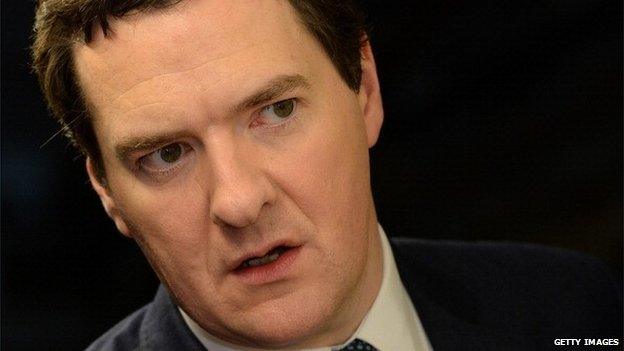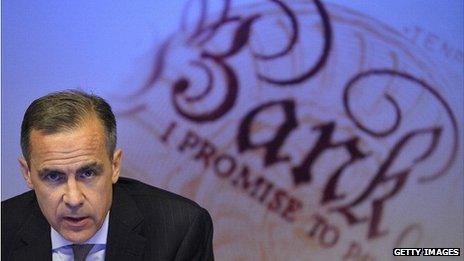Chancellor bends on bank leverage ratios
- Published

This is one of those dull but moderately important notes (and if you are awake after the next sentence, you are my kind of person).
The chancellor has this morning agreed that a binding leverage ratio, that could be higher than the international minimum, may be imposed on British banks by the Bank of England earlier than the current 2018 target - but it wants a year-long review by the Bank of how it would operate this ratio.
That is the gist of an exchange of letters between George Osborne and the newish governor of the Bank of England, Mark Carney.
I imagine you are asking yourself, at this juncture, why on earth this matters.
Well, for a number of reasons.
The easiest to understand is that it represents the newish governor of the Bank of England, Mark Carney, demonstrating that he is not the Treasury's poodle - in that he has picked up the determination of the previous governor, Lord King, to accelerate the introduction of a leverage ratio and followed it through.
Mr Carney, in his letter to Mr Osborne, says his belief is that the existence of a fairly stringent leverage ratio in Canada, during the boom years, was an important reason why Canadian banks didn't go pop in the way that UK banks did in 2008 (and to remind you, Mr Carney's previous central banking berth was as governor of the Bank of Canada).
So although Mr Carney is a bit less religious about leverage ratios than Mr King (in fact, he is less religious about almost everything), he takes the view that they matter.
Now you may be scratching your head and wondering what on earth a leverage ratio may be.
Well, it is the ratio of a bank's loss-absorbing capital to its loans and investments.
And the important distinction between a leverage ratio and the Basel capital ratio - which has for years been the dominant supposed constraint on banks' capacity to lend - is that the Basel ratio attaches different risk weights to different categories of loan, whereas the leverage ratio does not.
Or to put it another way, the Basel ratio gives a financial incentive to banks to provide relatively more loans in the categories deemed by regulators to be less dangerous. Mortgages, for example, are among these putatively less risky loans.
The absence of a binding leverage ratio in places such as the UK meant that in the boom years, banks grew at a highly dangerous rate by loading up on those categories of loans and investments - such as mortgages and assorted bonds - which were deemed low-risk by short-sighted regulators.
And it's why the likes of HBOS, RBS and Northern Rock ended up with dangerously low levels of capital relative to their massive gross assets.
It is a big explanation for why taxpayers had to bail them out.
So the Bank of England hopes that the imposition of a leverage ratio will force banks to have a bigger buffer of loss-absorbing equity, to protect them against the inevitable shocks that lie ahead.
And it demonstrates that the Bank of England believes maximising the amount of pure loss-absorbing equity banks are forced to hold is the best initial defence against the kind of debacle we have seen at the Co-op - where a near collapse has led to an unseemly and hair-raising scramble to convert debt into this kind of equity, to keep the bank alive.

Mark Carney is a "bit less religious" about leverage ratios than his predecessor
But the chancellor has been concerned about the impact on banks' and building societies' ability to lend while the economy remains weak if a binding leverage ratio is introduced too soon.
As you may have deduced, a leverage ratio is disproportionately greater constraint on institutions that concentrate on providing mortgages - because most of them have traditionally met the Basel capital requirement while having a low leverage ratio.
And the last thing Mr Osborne wants to do is choke off mortgage lending when he is doing all he can - via Funding for Lending and Help to Buy - to stoke it up.
But he has today given a bit of ground, with the concession that a formal leverage ratio will be introduced earlier than the international target date of 2018, and that the Bank of England may be able to set it at a higher level than the 3% planned Basel minimum.
All that said, this international and domestic leverage debate is a bit of a mess.
First, most British banks - especially Barclays and Nationwide - would say they are already subject to leverage constraints, as part of the Bank of England's stress-testing regime.
Both Barclays and Nationwide have been forced to raise colossal amounts of additional capital to meet the Bank's stress-tested leverage target of 3% - and the fact that this has been imposed on them in an informal way would seem to them to be immaterial.
Second, there is desperate confusion for international banks about the leverage ratios they are required to meet in different parts of the world.
In the US, for example, a requirement for bank holding companies to have a 5% ratio and bank operating companies to have 6% is being introduced.
And that seems higher than the UK and Basel 3% - but the difference is not as great as it seems (huge securities transactions or repos and derivatives are netted in the US calculation of assets, making them smaller).
What is more, it is very unclear whether the UK leverage ratio will end up being more stringent than the EU one: there is an implication that the Bank of England would like it to be.
Here is the really interesting thing about the Bank of England's new review about all this.
The chancellor has said he wants the leverage ratio to be 3%, countermanding the recommendation of Independent Banking Commission he set up which wanted 4%.
My hunch is that we will end up with 4%, because the world - especially the US - seems to be heading in that direction.
There has been a very slow dropping of a very large penny among regulators and politicians that whatever the attractions of stimulating bank lending in the short term, the long-term costs of allowing banks to become dangerously short of equity capital are too great to contemplate (and the failure for years now of overstretched eurozone banks to support recovery shows quite how dangerous it is for banks to run short of capital).
UPDATE: 1520 GMT
I suppose I should have mentioned earlier that the members of the disbanded Parliamentary Commission on Banking Standards, chaired by Andrew Tyrie, are thrilled that the Treasury appears to have decided to bring forward the date at which the Bank of England can impose and vary leverage ratios.
It was something the Commission recommended almost a year ago, and the Chancellor then rejected, on the basis that 2018 felt quite early enough to Osborne.
As it happens, in the Lords today there is an amendment to the Banking Bill due to be debated today on this very issue.